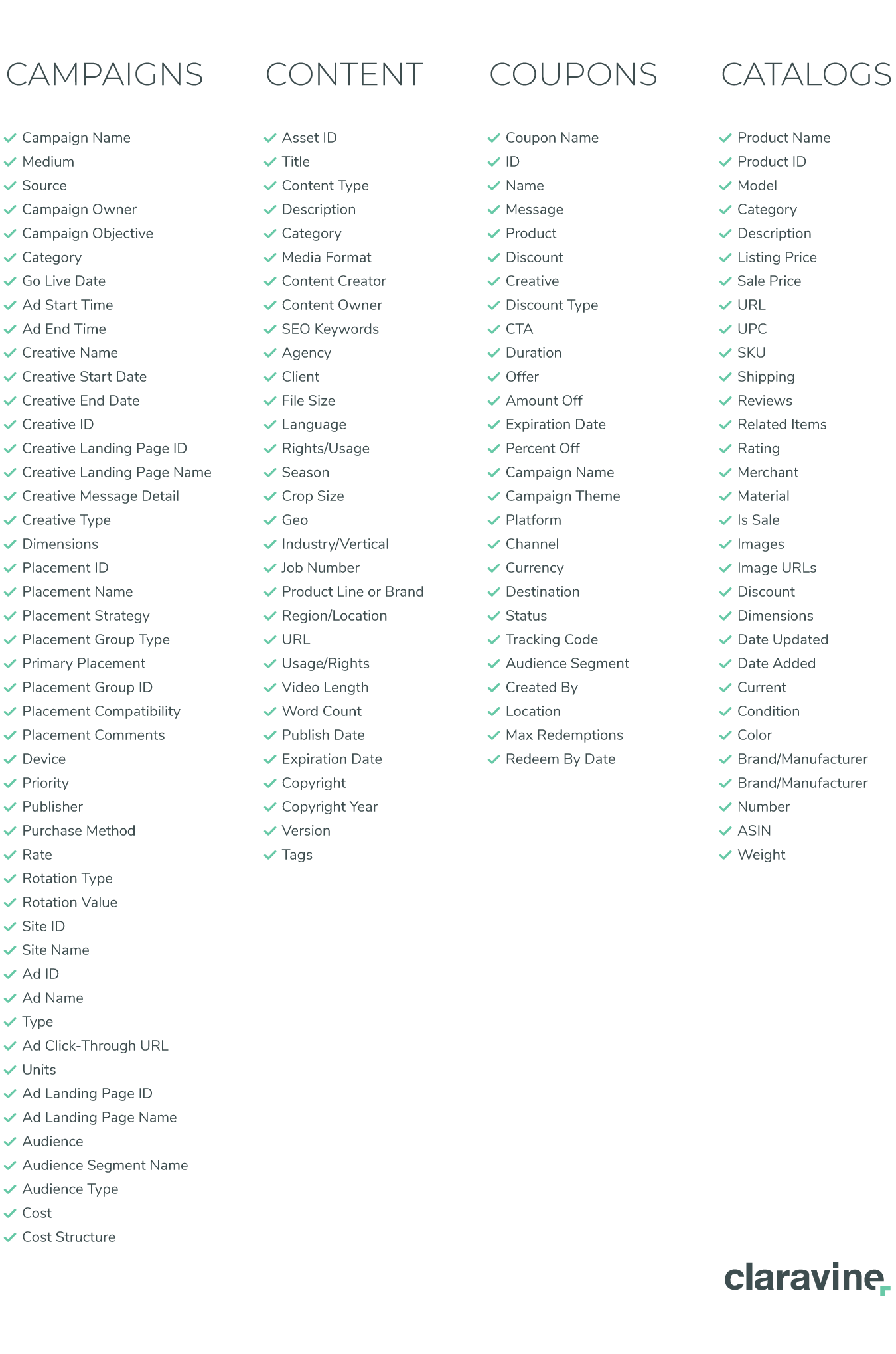Metadata: The Backbone of Strategic Content Operations

It’s easy to see that content is critical to marketing success. It’s what customer experiences are built on, after all. But managing it? That’s where things get complicated. Luckily, the notoriously murky realm of content operations gets a whole lot clearer if you introduce one critical element: metadata
When widely and consistently applied, content metadata allows for:
- Rapid analysis of content inventory and performance
- Efficient resource allocation
- Cross-team alignment
- Advanced personalization
- Consistent strategic execution
- Technology synchronization
To bring these wins to fruition, you’ll need to build a universal taxonomy that spans systems and teams; one that covers essential information without growing bloated and unwieldy. It also requires that the very concept of content metadata become central to the way work gets done, empowering everyone in your marketing organization to speak the same language about the work they do.
Let’s take a closer look at what content metadata is, why it’s so important, and where it belongs in your creation workflows.
Which Kinds of Content Metadata Should I Apply to My Content?
Your strategic taxonomy—that is, the organization of your metadata—represents the attributes most significant to the content you produce. Essentially, it should boil your content strategy down to a series of simple, universally understood tags. Every marketing organization’s taxonomy will look different, but most will cover some variation of the following:
- Persona: Who is the asset for?
- Buying stage: Where in the customer journey will a prospect or customer interact with this content?
- Product line: What particular product(s) is the content about or does it relate to?
- Industry: What industry does this content target?
Geography: What region or language is this content designed for
Publish and/or expiration date: When was the content created and/or when will it be out of date? - Content type: What kind of content is it? (Ex. Blog post, webpage, video, etc.)
Distribution channel: Where will this content be published? (Ex. Social media, internal sales portal, direct mail, etc.) - Internal team: Who bore primary responsibility for the content’s creation?
- Messaging theme: Which core strategic message (usually by quarter or year) does the content level up to?
- Campaign: What larger strategic initiative does this content support?
You’ll likely also employ additional tags that apply only for smaller subsets of the content you create. (For example, a tag like “SEO keyword” may be useful for blog posts and webpages.) These types of tags can help managers analyze specific campaigns, as well as keep creators on track.

How many tags should you use? The sweet spot will be enough to capture the important elements of your content, but not so many that they become cumbersome to apply or impossible to keep track of. As you build out your taxonomy, it’s helpful to ask: How will I or my team use this information to do our jobs better?
Why is Uniform Content Metadata So Important?
The insights gleaned from content metadata aren’t confined to any one department or stage of the content lifecycle. They help content strategists better analyze their top-performing messages and channels, creators get context for their work, demand generation teams create personalized customer journeys, digital marketers find and repurpose existing material—the list goes on.
But these insights are only meaningful if the metadata in question is universal. That means that there must be a consistent set of tags and their definitions that spans every marketing team—as well as the tools those teams use—so that everyone applying or analyzing metadata is doing so from the same, central playbook. Without uniformity, any potential insights will quickly be lost in translation.
Standardized content metadata brings six key values to a marketing organization:
1. Insight into content inventory
The question, “What content do we have?” doesn’t seem like a tough one, but it could stump more than a few marketing teams. Without a robust taxonomy, your content archive can become a black hole: It’s impossible to see inside, and attempting to dig in could leave you stuck forever.
With consistently applied metadata, however, it’s easy to slice and dice to consider what you have from a variety of angles. Want to see how many whitepapers from the last three years were written for a given persona? What about how many datasheets support a particular product line at the “consideration” stage of the buyer’s journey? Metadata leaves those answers and more at your fingertips.
2. Resource allocation
With these kinds of insights available, leaders can quickly assess the gaps that exist in their content strategy and determine where they’ll need to direct resources to address them. Where in the buyer’s journey are there lapses in current marketing content? What industries and personas are underserved? What outdated assets are muddying the waters?
In identifying what they’re missing, teams can better prioritize their limited time and resources. They can also use metadata filtering to work smarter, not harder, by finding existing content from which they can build rather than reinventing the wheel. With clear views into what content already exists, teams waste far less time on duplicative efforts.
3. Cross-team visibility and alignment
A shared taxonomy and universal understanding of its application is one of the most effective ways to align disparate teams and stakeholders. It helps strategists and team leaders get quick insight into what their teams (and others) are working on, and allows contributors across the creation process to understand assets at a glance and collaborate more efficiently.
4. Dynamic personalization
Content metadata is an essential prerequisite for sophisticated digital personalization. Whether you’re looking to serve up dynamic web content, personalize content suggestions, or rapidly adapt social media campaigns, it’s not enough to simply have data about your audience: You must have a comprehensive understanding of the content you have available to serve them, too.
5. Synchronization of systems and tools
Without a uniform taxonomy, integration and communication between tools breaks down. A consistent metadata structure allows for the transfer of information between disparate systems and teams without breaking things or losing crucial information.
When naming conventions are inconsistent or taxonomies don’t align, work gets lost, efforts are duplicated, and it’s impossible to trust the integrity of your data.
6. Better strategic execution
Your taxonomy is the distillation of your content strategy. As such, it allows marketing leadership to assess whether teams’ efforts reflect marketing priorities, while simultaneously forcing creators to make sure the work they do fits within the broader strategic landscape. We’ll dig into that second point in more detail, next.

Where Does Metadata Belong in the Content Creation Proce
ss?
Tagging content metadata should be the first step in any content creation workflow.
It’s easy to think of metadata as something applied retroactively: a set of labels slapped on an asset after it’s finished so it can be filed away. But metadata is so much more than a filing system. Sure, it helps you understand content once it’s complete, but it also helps to ensure the right content gets made from the get-go.
In requiring that metadata is completed before work begins, you’ll ensure creators…
Create with strategic intent
Metadata provides strategic context, reducing the need for extensive editing down the road.
Tagging at the outset is also an excellent gatekeeping mechanism. It forces a creator to perform a gut-check and ask: Why is this being created? Who is it for? What message and/or strategic initiative does it advance? If none of the available tags seem to apply, it’s a giant red flag that the project might not be aligned to a larger strategy.
Align with fellow stakeholders from the start
The original creator won’t always have all the information they need to tag an asset completely, but this is a feature, not a bug. In many cases, this is an ideal opportunity to ensure the creator checks in with stakeholders who may normally not be engaged until later in the process. By, for example, syncing with the SEO team at the outset about a webpage’s target keywords, a creator can submit a more strategic first draft and avoid extra work later in the process.
Enjoy smoother handoffs
Beyond initial alignment, metadata is like a cheat-sheet for every stakeholder who taps in during the creation process. It provides an SME or editor, for example, with instant context about what the asset is, who it’s for, and where it’s going, which reduces potential bottlenecks in the process.
Your First Step to Metadata Bliss: Creating a Uniform Taxonomy
Seasoned marketers will find that aligning around a universal content taxonomy will look a lot like aligning around a content operations strategy. In both cases, a clear and shared vision requires that everyone agree on what’s important and what the organization is trying to accomplish. When marketing teams are aligned on these foundational tenets, they’ll find it infinitely easier to come together and build a taxonomy that works for everyone.
To begin the project, you as the champion will need to find those fellow leaders who see the value of building a shared taxonomy and are willing to put in the work to make it happen. With buy-in from executive leadership, gather everyone in a room—virtual or otherwise—and don’t be afraid to let things start out messy as you talk through what you’ll need to track and how it should be defined and organized. Make sure your steering committee acts as ambassadors, not dictators; each should take iterations back to their own team for feedback and buy-in to ensure everyone feels represented in the outcome.
This isn’t always a simple process. It requires an upfront investment of time and effort and a willingness to collaborate across various groups that may historically have operated in silos. But in exchange for your efforts, you’ll get more than a data structure: You’ll have unprecedented insight into your content operation and empower every marketer to maximize their strategic impact.
About the Author

Zoë is a writer, marketer, and co-author of Mastering One Voice: A Marketing Fable and Field Guide to Content Operations. When she’s not holding a pen, you’ll find her immersed in a book, talking politics, or agonizing over the mediocrity of Cal Bears athletics.



